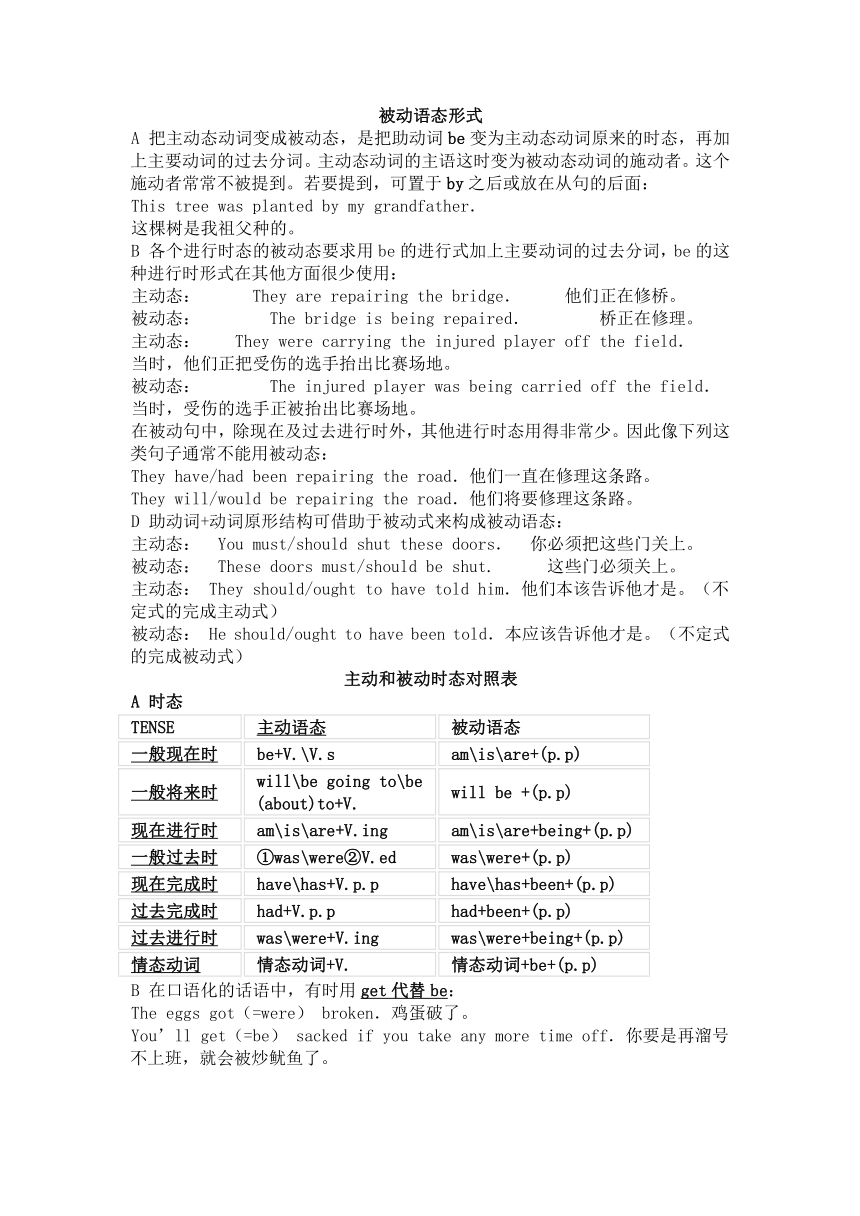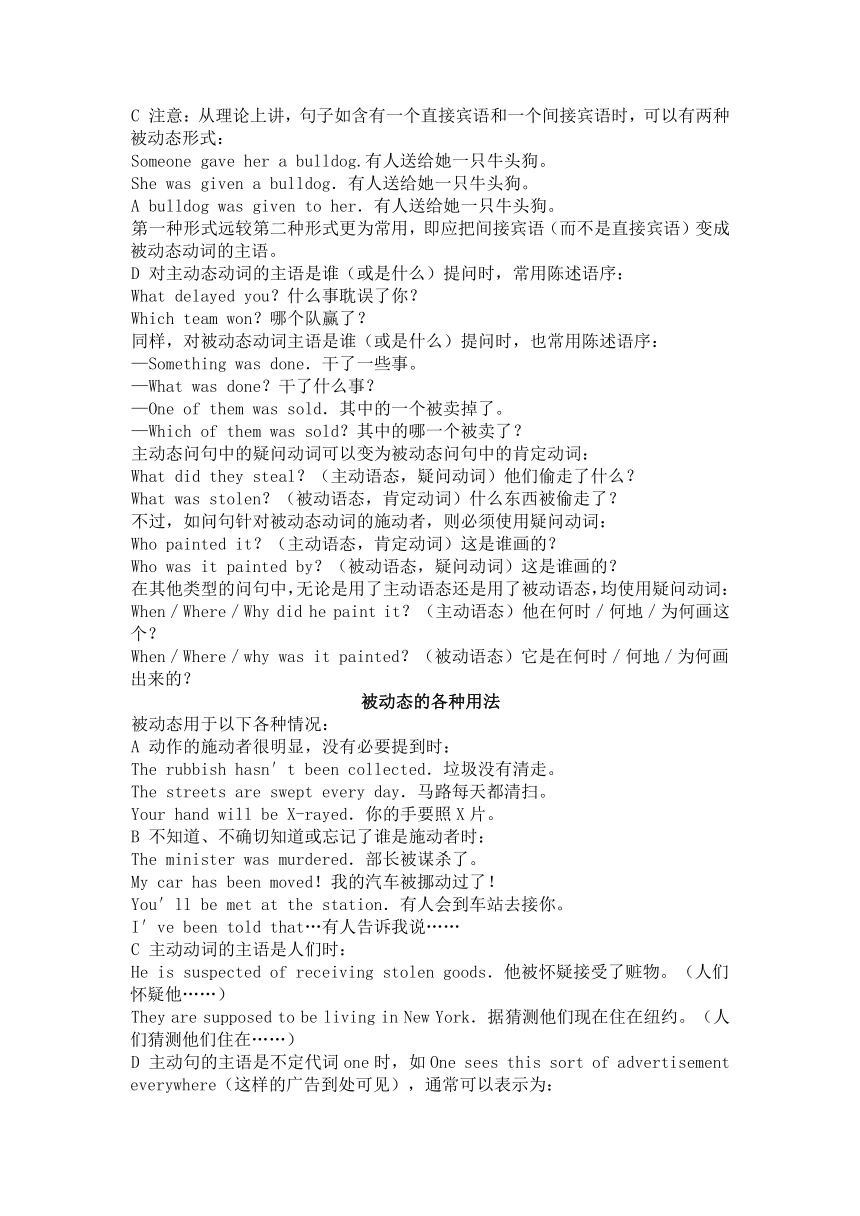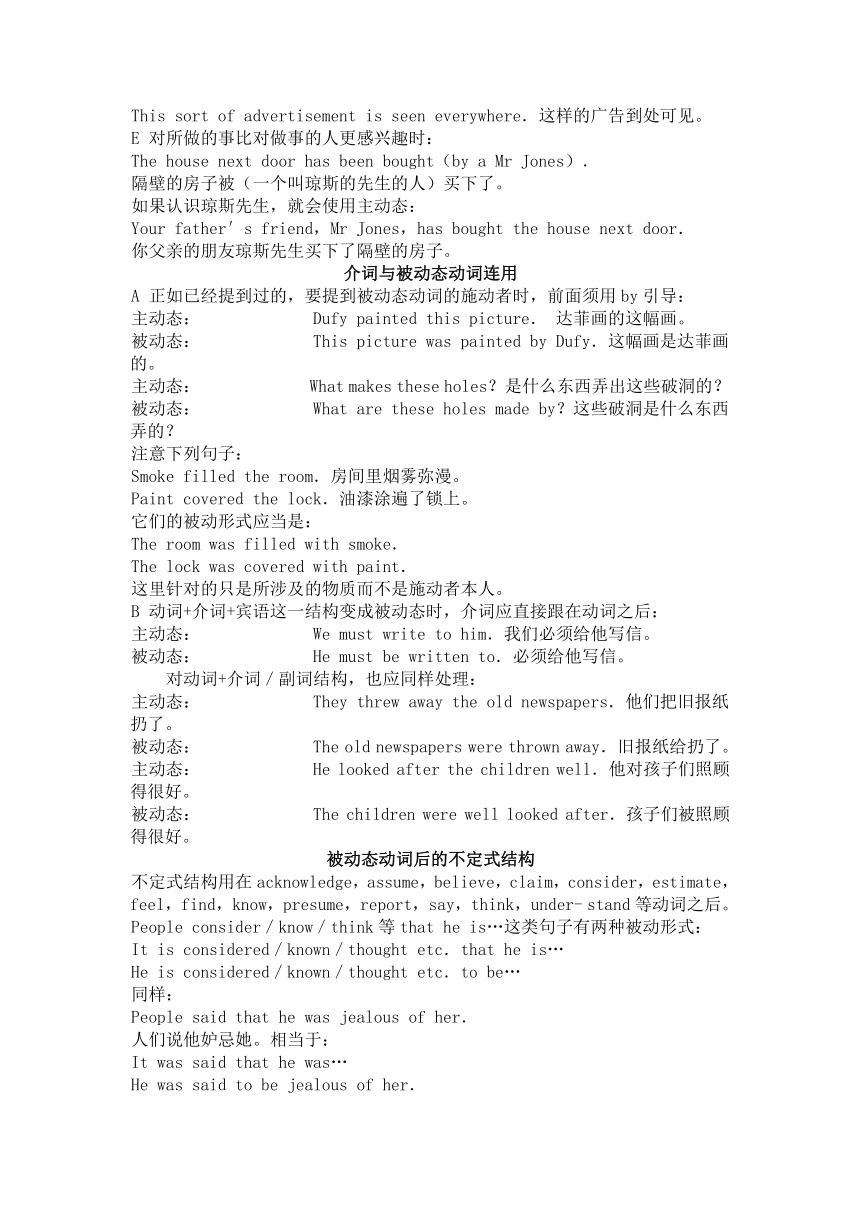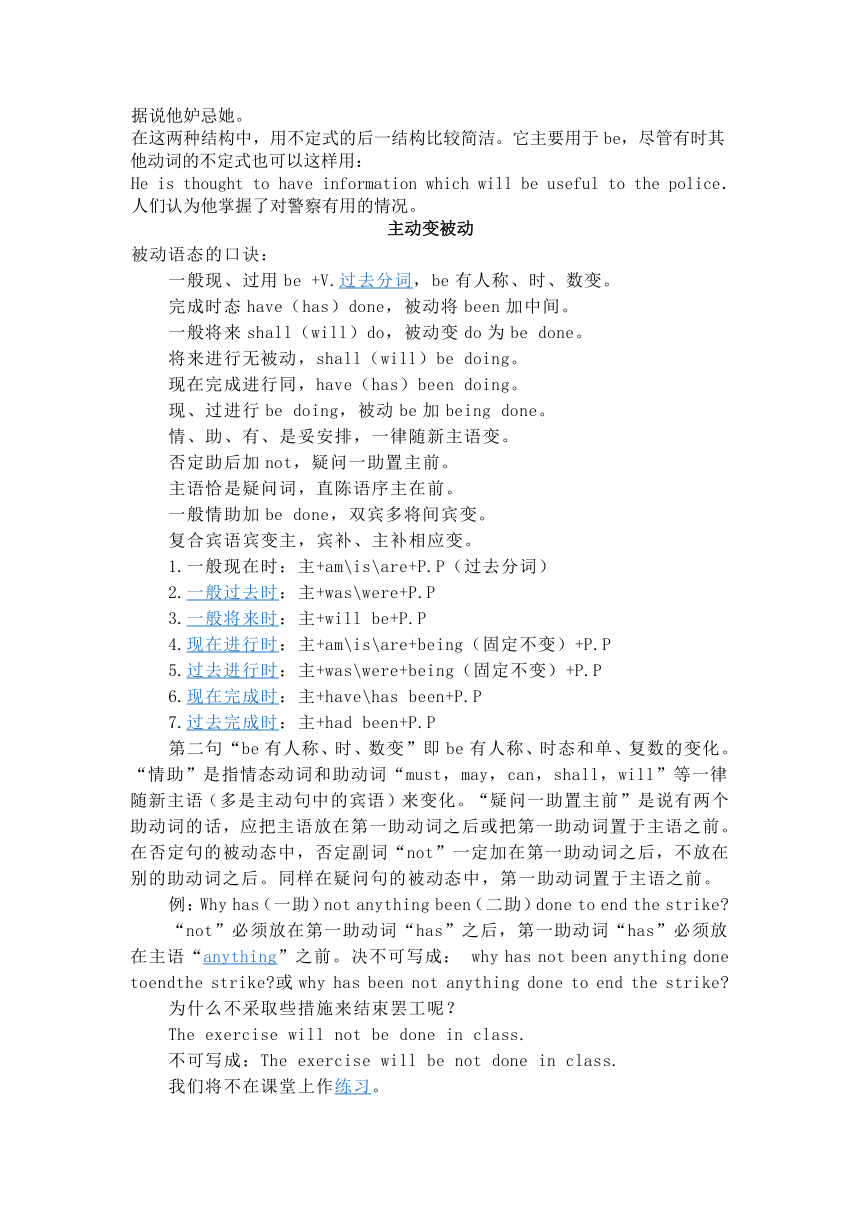被动语态教案
图片预览




文档简介
被动语态形式
A 把主动态动词变成被动态,是把助动词be变为主动态动词原来的时态,再加上主要动词的过去分词。主动态动词的主语这时变为被动态动词的施动者。这个施动者常常不被提到。若要提到,可置于by之后或放在从句的后面:
This tree was planted by my grandfather.
这棵树是我祖父种的。
B 各个进行时态的被动态要求用be的进行式加上主要动词的过去分词,be的这种进行时形式在其他方面很少使用:
主动态: They are repairing the bridge. 他们正在修桥。
被动态: The bridge is being repaired. 桥正在修理。
主动态: They were carrying the injured player off the field.
当时,他们正把受伤的选手抬出比赛场地。
被动态: The injured player was being carried off the field.
当时,受伤的选手正被抬出比赛场地。
在被动句中,除现在及过去进行时外,其他进行时态用得非常少。因此像下列这类句子通常不能用被动态:
They have/had been repairing the road.他们一直在修理这条路。
They will/would be repairing the road.他们将要修理这条路。
D 助动词+动词原形结构可借助于被动式来构成被动语态:
主动态: You must/should shut these doors. 你必须把这些门关上。
被动态: These doors must/should be shut. 这些门必须关上。
主动态: They should/ought to have told him.他们本该告诉他才是。(不定式的完成主动式)
被动态: He should/ought to have been told.本应该告诉他才是。(不定式的完成被动式)
主动和被动时态对照表
A 时态
TENSE 主动语态 ( http: / / www.21cnjy.com / " \o "欢迎登陆21世纪教育网" \t "_blank ) 被动语态
一般现在时 ( http: / / www.21cnjy.com / " \o "欢迎登陆21世纪教育网" \t "_blank ) be+V.\V.s am\is\are+(p.p)
一般将来时 ( http: / / www.21cnjy.com / " \o "欢迎登陆21世纪教育网" \t "_blank ) will\be going to\be (about)to+V. will be +(p.p)
现在进行时 ( http: / / www.21cnjy.com / " \o "欢迎登陆21世纪教育网" \t "_blank ) am\is\are+V.ing am\is\are+being+(p.p)
一般过去时 ( http: / / www.21cnjy.com / " \o "欢迎登陆21世纪教育网" \t "_blank ) ①was\were②V.ed was\were+(p.p)
现在完成时 ( http: / / www.21cnjy.com / " \o "欢迎登陆21世纪教育网" \t "_blank ) have\has+V.p.p have\has+been+(p.p)
过去完成时 ( http: / / www.21cnjy.com / " \o "欢迎登陆21世纪教育网" \t "_blank ) had+V.p.p had+been+(p.p)
过去进行时 ( http: / / www.21cnjy.com / " \o "欢迎登陆21世纪教育网" \t "_blank ) was\were+V.ing was\were+being+(p.p)
情态动词 ( http: / / www.21cnjy.com / " \o "欢迎登陆21世纪教育网" \t "_blank ) 情态动词+V. 情态动词+be+(p.p)
B 在口语化的话语中,有时用get代替be:
The eggs got(=were) broken.鸡蛋破了。
You’ll get(=be) sacked if you take any more time off.你要是再溜号不上班,就会被炒鱿鱼了。
C 注意:从理论上讲,句子如含有一个直接宾语和一个间接宾语时,可以有两种被动态形式:
Someone gave her a bulldog.有人送给她一只牛头狗。
She was given a bulldog.有人送给她一只牛头狗。
A bulldog was given to her.有人送给她一只牛头狗。
第一种形式远较第二种形式更为常用,即应把间接宾语(而不是直接宾语)变成被动态动词的主语。
D 对主动态动词的主语是谁(或是什么)提问时,常用陈述语序:
What delayed you?什么事耽误了你?
Which team won?哪个队赢了?
同样,对被动态动词主语是谁(或是什么)提问时,也常用陈述语序:
—Something was done.干了一些事。
—What was done?干了什么事?
—One of them was sold.其中的一个被卖掉了。
—Which of them was sold?其中的哪一个被卖了?
主动态问句中的疑问动词可以变为被动态问句中的肯定动词:
What did they steal?(主动语态,疑问动词)他们偷走了什么?
What was stolen?(被动语态,肯定动词)什么东西被偷走了?
不过,如问句针对被动态动词的施动者,则必须使用疑问动词:
Who painted it?(主动语态,肯定动词)这是谁画的?
Who was it painted by?(被动语态,疑问动词)这是谁画的?
在其他类型的问句中,无论是用了主动语态还是用了被动语态,均使用疑问动词:
When/Where/Why did he paint it?(主动语态)他在何时/何地/为何画这个?
When/Where/why was it painted?(被动语态)它是在何时/何地/为何画出来的?
被动态的各种用法
被动态用于以下各种情况:
A 动作的施动者很明显,没有必要提到时:
The rubbish hasn′t been collected.垃圾没有清走。
The streets are swept every day.马路每天都清扫。
Your hand will be X-rayed.你的手要照X片。
B 不知道、不确切知道或忘记了谁是施动者时:
The minister was murdered.部长被谋杀了。
My car has been moved!我的汽车被挪动过了!
You′ll be met at the station.有人会到车站去接你。
I′ve been told that…有人告诉我说……
C 主动动词的主语是人们时:
He is suspected of receiving stolen goods.他被怀疑接受了赃物。(人们怀疑他……)
They are supposed to be living in New York.据猜测他们现在住在纽约。(人们猜测他们住在……)
D 主动句的主语是不定代词one时,如One sees this sort of advertisement everywhere(这样的广告到处可见),通常可以表示为:
This sort of advertisement is seen everywhere.这样的广告到处可见。
E 对所做的事比对做事的人更感兴趣时:
The house next door has been bought(by a Mr Jones).
隔壁的房子被(一个叫琼斯的先生的人)买下了。
如果认识琼斯先生,就会使用主动态:
Your father′s friend,Mr Jones,has bought the house next door.
你父亲的朋友琼斯先生买下了隔壁的房子。
介词与被动态动词连用
A 正如已经提到过的,要提到被动态动词的施动者时,前面须用by引导:
主动态: Dufy painted this picture. 达菲画的这幅画。
被动态: This picture was painted by Dufy.这幅画是达菲画的。
主动态: What makes these holes?是什么东西弄出这些破洞的?
被动态: What are these holes made by?这些破洞是什么东西弄的?
注意下列句子:
Smoke filled the room.房间里烟雾弥漫。
Paint covered the lock.油漆涂遍了锁上。
它们的被动形式应当是:
The room was filled with smoke.
The lock was covered with paint.
这里针对的只是所涉及的物质而不是施动者本人。
B 动词+介词+宾语这一结构变成被动态时,介词应直接跟在动词之后:
主动态: We must write to him.我们必须给他写信。
被动态: He must be written to.必须给他写信。
对动词+介词/副词结构,也应同样处理:
主动态: They threw away the old newspapers.他们把旧报纸扔了。
被动态: The old newspapers were thrown away.旧报纸给扔了。
主动态: He looked after the children well.他对孩子们照顾得很好。
被动态: The children were well looked after.孩子们被照顾得很好。
被动态动词后的不定式结构
不定式结构用在acknowledge,assume,believe,claim,consider,estimate,feel,find,know,presume,report,say,think,under- stand等动词之后。
People consider/know/think等that he is…这类句子有两种被动形式:
It is considered/known/thought etc.that he is…
He is considered/known/thought etc.to be…
同样:
People said that he was jealous of her.
人们说他妒忌她。相当于:
It was said that he was…
He was said to be jealous of her.
据说他妒忌她。
在这两种结构中,用不定式的后一结构比较简洁。它主要用于be,尽管有时其他动词的不定式也可以这样用:
He is thought to have information which will be useful to the police.
人们认为他掌握了对警察有用的情况。
主动变被动
被动语态的口诀:
一般现、过用be +V.过去分词 ( http: / / www.21cnjy.com / " \o "欢迎登陆21世纪教育网" \t "_blank ),be有人称、时、数变。
完成时态have(has)done,被动将been加中间。
一般将来shall(will)do,被动变do为be done。
将来进行无被动,shall(will)be doing。
现在完成进行同,have(has)been doing。
现、过进行be doing,被动be加being done。
情、助、有、是妥安排,一律随新主语变。
否定助后加not,疑问一助置主前。
主语恰是疑问词,直陈语序主在前。
一般情助加be done,双宾多将间宾变。
复合宾语宾变主,宾补、主补相应变。
1.一般现在时:主+am\is\are+P.P(过去分词)
2.一般过去时 ( http: / / www.21cnjy.com / " \o "欢迎登陆21世纪教育网" \t "_blank ):主+was\were+P.P
3.一般将来时 ( http: / / www.21cnjy.com / " \o "欢迎登陆21世纪教育网" \t "_blank ):主+will be+P.P
4.现在进行时 ( http: / / www.21cnjy.com / " \o "欢迎登陆21世纪教育网" \t "_blank ):主+am\is\are+being(固定不变)+P.P
5.过去进行时 ( http: / / www.21cnjy.com / " \o "欢迎登陆21世纪教育网" \t "_blank ):主+was\were+being(固定不变)+P.P
6.现在完成时 ( http: / / www.21cnjy.com / " \o "欢迎登陆21世纪教育网" \t "_blank ):主+have\has been+P.P
7.过去完成时 ( http: / / www.21cnjy.com / " \o "欢迎登陆21世纪教育网" \t "_blank ):主+had been+P.P
第二句“be有人称、时、数变”即be有人称、时态和单、复数的变化。“情助”是指情态动词和助动词“must,may,can,shall,will”等一律随新主语(多是主动句中的宾语)来变化。“疑问一助置主前”是说有两个助动词的话,应把主语放在第一助动词之后或把第一助动词置于主语之前。在否定句的被动态中,否定副词“not”一定加在第一助动词之后,不放在别的助动词之后。同样在疑问句的被动态中,第一助动词置于主语之前。
例:Why has(一助)not anything been(二助)done to end the strike
“not”必须放在第一助动词“has”之后,第一助动词“has”必须放在主语“anything ( http: / / www.21cnjy.com / " \o "欢迎登陆21世纪教育网" \t "_blank )”之前。决不可写成: why has not been anything done toendthe strike 或why has been not anything done to end the strike
为什么不采取些措施来结束罢工呢?
The exercise will not be done in class.
不可写成:The exercise will be not done in class.
我们将不在课堂上作练习 ( http: / / www.21cnjy.com / " \o "欢迎登陆21世纪教育网" \t "_blank )。
In what other way could(一助)information about Mars be(二助)obtained
用什么别的途径能获得火星的资料呢?
Why had he been imprisoned
他为何入狱的?
Need she be told about it
需要告诉他吗?
主动:No one has ever equalled your record.
被动:Your record has never been equaled.
没人刷新你的记录。
主语恰是疑问词,直陈语序主在前
凡主语恰好是一个疑问词或由疑问词来修饰主语时,后面要用陈述语序。
例:What(主语)could be dropped from a satellite
卫星上扔下何物?
What measures(主语)are being taken to develop this new science (主语为疑问词“what”所修饰)
正在采取什么措施来发展这门新科学?
What kind of device(主语)is needed to make the control system simple (主语为疑问词所修饰)
需要什么装置来使控制系统简化?
what has been done to improve the techniques
采取了什么措施来改进这些技术的?(“what”恰是句子的主语)
应指出的是有的学生把We study diligently和She could see herself clearly in the mirror.都硬行变成被动了,殊不知不及物动词通常是没有被动态的。关于不及物动词、反身代词动词、同源宾语动词、系词、感官使役动词 ( http: / / www.21cnjy.com / " \o "欢迎登陆21世纪教育网" \t "_blank )、短语动词的被动态。
主动句变为被动句所遵循的4个步骤:
1、把原主动句中的宾语变为被动句 ( http: / / www.21cnjy.com / " \o "欢迎登陆21世纪教育网" \t "_blank )的主语
2、把动词变为被动形式即be +过去分词,并注意其人称和数随主语的变化,而动词的时态则保持不变。
3、原主动句的主语如需要则放在by后面以它的宾格形式出现(注代词的宾格),如不需要则可省略。
4、其它的成分(定语、状语)不变。
不用被动语态的情况
1) 不及物动词或动词短语无被动语态:
appear, die disappear, end (vi. 结束), fail, happen, last, lie, remain, sit, spread, stand
break out爆发, come true实现, fall asleep入睡, keep silence保持安静, look for寻找,lose heart失去信心, take place发生,.
After the fire, very little remained of my house.
比较: rise上升, fall下降, happen是不及物动词;raise提高、养育、升起, seat是及物动词。
(错) The price has been risen.
(对) The price has risen.
(错) The accident was happened last week.
(对) The accident happened last week.
(错) The price has raised.
(对) The price has been raised.
(错) Please seat.
(对) Please be seated.
要想正确地使用被动语态,就须注意哪些动词是及物的,哪些是不及物的。特别是一词多义的动词往往有两种用法。解决这一问题唯有在学习过程中多留意积累。
2) 不能用于被动语态的及物动词或动词短语:
fit, have, hold, marry, own, wish, cost, notice, watch agree with, arrive at / in, shake hands with与握手, succeed in在方面成功, suffer from遭受, happen to偶然发生, take part in参加, walk into走进, belong to属于
This key just fits the lock.
Your story agrees with what had already been heard.
3) 系动词无被动语态:
appear, be, become, fall, feel, get, grow, keep, look, remain, seem, smell, sound, stay, taste, turn,prove
It sounds good.
4) 带同源宾语的及物动词,反身代词,相互代词,不能用于被动语态:
die, death, dream, live, life
She dreamed a bad dream last night.
5) 当宾语是不定式时,很少用于被动语态。
(对) She likes to swim.
(错) To swim is liked by her.
被动形式表示主动意义
be determined, be pleased, be graduated (from), be finished, be prepared (for), be occupied (in), get marries
He is graduated from a famous university.
他毕业于一所有名的大学。
注意: 表示同某人结婚,用marry sb. 或get married to sb. 都可。
He married a rich girl.
He got married to a rich girl.
need/want/require/worth
注意:当 need, want, require, worth(形容词)后面接doing也可以表示被动。
Your hair wants cutting. 你的头发该理了。
The floor requires washing. 地板需要冲洗。
The book is worth reading. 这本书值得一读。
典型例题
The library needs___, but it'll have to wait until Sunday.
A. cleaning B. be cleaned C. clean D. being cleaned
答案A. need (实意) +n /to do,need (情态)+ do,当为被动语态时,还可need + doing. 本题考最后一种用法,选A。如有to be clean 则也为正确答案。
典:done,"不可能已经"。must not do 不可以(用于一般现在时)。
主动形式表示被动意义
A wash, clean, cook, iron, look, cut, sell, read, wear, feel, draw, write, sell, drive…
The book sells well. 这本书销路好。
This knife cuts easily. 这刀子很好用。
B blame, let(出租), remain, keep, rent, build
I was to blame for the accident.
Much work remains.
C 在need, require, want, worth (形容词), deserve后的动名词必须用主动形式。
The door needs repairing.= The door needs to be repaired.
This room needs cleaning. 这房间应该打扫一下。
This book is worth reading. 这本书值得一读。
D 特殊结构:make sb. heard / understood (使别人能听见/理解自己),have sth. done ( 要某人做某事)。
E too…to句型有时有被动含义。
They are too nice to use just at present. 他们太好了,但目前用不上。(被使用)
F 形容词+不定式有被动含义。
G be worth+-doing 中-ing主动表被动。
The book is worth reading.
A 把主动态动词变成被动态,是把助动词be变为主动态动词原来的时态,再加上主要动词的过去分词。主动态动词的主语这时变为被动态动词的施动者。这个施动者常常不被提到。若要提到,可置于by之后或放在从句的后面:
This tree was planted by my grandfather.
这棵树是我祖父种的。
B 各个进行时态的被动态要求用be的进行式加上主要动词的过去分词,be的这种进行时形式在其他方面很少使用:
主动态: They are repairing the bridge. 他们正在修桥。
被动态: The bridge is being repaired. 桥正在修理。
主动态: They were carrying the injured player off the field.
当时,他们正把受伤的选手抬出比赛场地。
被动态: The injured player was being carried off the field.
当时,受伤的选手正被抬出比赛场地。
在被动句中,除现在及过去进行时外,其他进行时态用得非常少。因此像下列这类句子通常不能用被动态:
They have/had been repairing the road.他们一直在修理这条路。
They will/would be repairing the road.他们将要修理这条路。
D 助动词+动词原形结构可借助于被动式来构成被动语态:
主动态: You must/should shut these doors. 你必须把这些门关上。
被动态: These doors must/should be shut. 这些门必须关上。
主动态: They should/ought to have told him.他们本该告诉他才是。(不定式的完成主动式)
被动态: He should/ought to have been told.本应该告诉他才是。(不定式的完成被动式)
主动和被动时态对照表
A 时态
TENSE 主动语态 ( http: / / www.21cnjy.com / " \o "欢迎登陆21世纪教育网" \t "_blank ) 被动语态
一般现在时 ( http: / / www.21cnjy.com / " \o "欢迎登陆21世纪教育网" \t "_blank ) be+V.\V.s am\is\are+(p.p)
一般将来时 ( http: / / www.21cnjy.com / " \o "欢迎登陆21世纪教育网" \t "_blank ) will\be going to\be (about)to+V. will be +(p.p)
现在进行时 ( http: / / www.21cnjy.com / " \o "欢迎登陆21世纪教育网" \t "_blank ) am\is\are+V.ing am\is\are+being+(p.p)
一般过去时 ( http: / / www.21cnjy.com / " \o "欢迎登陆21世纪教育网" \t "_blank ) ①was\were②V.ed was\were+(p.p)
现在完成时 ( http: / / www.21cnjy.com / " \o "欢迎登陆21世纪教育网" \t "_blank ) have\has+V.p.p have\has+been+(p.p)
过去完成时 ( http: / / www.21cnjy.com / " \o "欢迎登陆21世纪教育网" \t "_blank ) had+V.p.p had+been+(p.p)
过去进行时 ( http: / / www.21cnjy.com / " \o "欢迎登陆21世纪教育网" \t "_blank ) was\were+V.ing was\were+being+(p.p)
情态动词 ( http: / / www.21cnjy.com / " \o "欢迎登陆21世纪教育网" \t "_blank ) 情态动词+V. 情态动词+be+(p.p)
B 在口语化的话语中,有时用get代替be:
The eggs got(=were) broken.鸡蛋破了。
You’ll get(=be) sacked if you take any more time off.你要是再溜号不上班,就会被炒鱿鱼了。
C 注意:从理论上讲,句子如含有一个直接宾语和一个间接宾语时,可以有两种被动态形式:
Someone gave her a bulldog.有人送给她一只牛头狗。
She was given a bulldog.有人送给她一只牛头狗。
A bulldog was given to her.有人送给她一只牛头狗。
第一种形式远较第二种形式更为常用,即应把间接宾语(而不是直接宾语)变成被动态动词的主语。
D 对主动态动词的主语是谁(或是什么)提问时,常用陈述语序:
What delayed you?什么事耽误了你?
Which team won?哪个队赢了?
同样,对被动态动词主语是谁(或是什么)提问时,也常用陈述语序:
—Something was done.干了一些事。
—What was done?干了什么事?
—One of them was sold.其中的一个被卖掉了。
—Which of them was sold?其中的哪一个被卖了?
主动态问句中的疑问动词可以变为被动态问句中的肯定动词:
What did they steal?(主动语态,疑问动词)他们偷走了什么?
What was stolen?(被动语态,肯定动词)什么东西被偷走了?
不过,如问句针对被动态动词的施动者,则必须使用疑问动词:
Who painted it?(主动语态,肯定动词)这是谁画的?
Who was it painted by?(被动语态,疑问动词)这是谁画的?
在其他类型的问句中,无论是用了主动语态还是用了被动语态,均使用疑问动词:
When/Where/Why did he paint it?(主动语态)他在何时/何地/为何画这个?
When/Where/why was it painted?(被动语态)它是在何时/何地/为何画出来的?
被动态的各种用法
被动态用于以下各种情况:
A 动作的施动者很明显,没有必要提到时:
The rubbish hasn′t been collected.垃圾没有清走。
The streets are swept every day.马路每天都清扫。
Your hand will be X-rayed.你的手要照X片。
B 不知道、不确切知道或忘记了谁是施动者时:
The minister was murdered.部长被谋杀了。
My car has been moved!我的汽车被挪动过了!
You′ll be met at the station.有人会到车站去接你。
I′ve been told that…有人告诉我说……
C 主动动词的主语是人们时:
He is suspected of receiving stolen goods.他被怀疑接受了赃物。(人们怀疑他……)
They are supposed to be living in New York.据猜测他们现在住在纽约。(人们猜测他们住在……)
D 主动句的主语是不定代词one时,如One sees this sort of advertisement everywhere(这样的广告到处可见),通常可以表示为:
This sort of advertisement is seen everywhere.这样的广告到处可见。
E 对所做的事比对做事的人更感兴趣时:
The house next door has been bought(by a Mr Jones).
隔壁的房子被(一个叫琼斯的先生的人)买下了。
如果认识琼斯先生,就会使用主动态:
Your father′s friend,Mr Jones,has bought the house next door.
你父亲的朋友琼斯先生买下了隔壁的房子。
介词与被动态动词连用
A 正如已经提到过的,要提到被动态动词的施动者时,前面须用by引导:
主动态: Dufy painted this picture. 达菲画的这幅画。
被动态: This picture was painted by Dufy.这幅画是达菲画的。
主动态: What makes these holes?是什么东西弄出这些破洞的?
被动态: What are these holes made by?这些破洞是什么东西弄的?
注意下列句子:
Smoke filled the room.房间里烟雾弥漫。
Paint covered the lock.油漆涂遍了锁上。
它们的被动形式应当是:
The room was filled with smoke.
The lock was covered with paint.
这里针对的只是所涉及的物质而不是施动者本人。
B 动词+介词+宾语这一结构变成被动态时,介词应直接跟在动词之后:
主动态: We must write to him.我们必须给他写信。
被动态: He must be written to.必须给他写信。
对动词+介词/副词结构,也应同样处理:
主动态: They threw away the old newspapers.他们把旧报纸扔了。
被动态: The old newspapers were thrown away.旧报纸给扔了。
主动态: He looked after the children well.他对孩子们照顾得很好。
被动态: The children were well looked after.孩子们被照顾得很好。
被动态动词后的不定式结构
不定式结构用在acknowledge,assume,believe,claim,consider,estimate,feel,find,know,presume,report,say,think,under- stand等动词之后。
People consider/know/think等that he is…这类句子有两种被动形式:
It is considered/known/thought etc.that he is…
He is considered/known/thought etc.to be…
同样:
People said that he was jealous of her.
人们说他妒忌她。相当于:
It was said that he was…
He was said to be jealous of her.
据说他妒忌她。
在这两种结构中,用不定式的后一结构比较简洁。它主要用于be,尽管有时其他动词的不定式也可以这样用:
He is thought to have information which will be useful to the police.
人们认为他掌握了对警察有用的情况。
主动变被动
被动语态的口诀:
一般现、过用be +V.过去分词 ( http: / / www.21cnjy.com / " \o "欢迎登陆21世纪教育网" \t "_blank ),be有人称、时、数变。
完成时态have(has)done,被动将been加中间。
一般将来shall(will)do,被动变do为be done。
将来进行无被动,shall(will)be doing。
现在完成进行同,have(has)been doing。
现、过进行be doing,被动be加being done。
情、助、有、是妥安排,一律随新主语变。
否定助后加not,疑问一助置主前。
主语恰是疑问词,直陈语序主在前。
一般情助加be done,双宾多将间宾变。
复合宾语宾变主,宾补、主补相应变。
1.一般现在时:主+am\is\are+P.P(过去分词)
2.一般过去时 ( http: / / www.21cnjy.com / " \o "欢迎登陆21世纪教育网" \t "_blank ):主+was\were+P.P
3.一般将来时 ( http: / / www.21cnjy.com / " \o "欢迎登陆21世纪教育网" \t "_blank ):主+will be+P.P
4.现在进行时 ( http: / / www.21cnjy.com / " \o "欢迎登陆21世纪教育网" \t "_blank ):主+am\is\are+being(固定不变)+P.P
5.过去进行时 ( http: / / www.21cnjy.com / " \o "欢迎登陆21世纪教育网" \t "_blank ):主+was\were+being(固定不变)+P.P
6.现在完成时 ( http: / / www.21cnjy.com / " \o "欢迎登陆21世纪教育网" \t "_blank ):主+have\has been+P.P
7.过去完成时 ( http: / / www.21cnjy.com / " \o "欢迎登陆21世纪教育网" \t "_blank ):主+had been+P.P
第二句“be有人称、时、数变”即be有人称、时态和单、复数的变化。“情助”是指情态动词和助动词“must,may,can,shall,will”等一律随新主语(多是主动句中的宾语)来变化。“疑问一助置主前”是说有两个助动词的话,应把主语放在第一助动词之后或把第一助动词置于主语之前。在否定句的被动态中,否定副词“not”一定加在第一助动词之后,不放在别的助动词之后。同样在疑问句的被动态中,第一助动词置于主语之前。
例:Why has(一助)not anything been(二助)done to end the strike
“not”必须放在第一助动词“has”之后,第一助动词“has”必须放在主语“anything ( http: / / www.21cnjy.com / " \o "欢迎登陆21世纪教育网" \t "_blank )”之前。决不可写成: why has not been anything done toendthe strike 或why has been not anything done to end the strike
为什么不采取些措施来结束罢工呢?
The exercise will not be done in class.
不可写成:The exercise will be not done in class.
我们将不在课堂上作练习 ( http: / / www.21cnjy.com / " \o "欢迎登陆21世纪教育网" \t "_blank )。
In what other way could(一助)information about Mars be(二助)obtained
用什么别的途径能获得火星的资料呢?
Why had he been imprisoned
他为何入狱的?
Need she be told about it
需要告诉他吗?
主动:No one has ever equalled your record.
被动:Your record has never been equaled.
没人刷新你的记录。
主语恰是疑问词,直陈语序主在前
凡主语恰好是一个疑问词或由疑问词来修饰主语时,后面要用陈述语序。
例:What(主语)could be dropped from a satellite
卫星上扔下何物?
What measures(主语)are being taken to develop this new science (主语为疑问词“what”所修饰)
正在采取什么措施来发展这门新科学?
What kind of device(主语)is needed to make the control system simple (主语为疑问词所修饰)
需要什么装置来使控制系统简化?
what has been done to improve the techniques
采取了什么措施来改进这些技术的?(“what”恰是句子的主语)
应指出的是有的学生把We study diligently和She could see herself clearly in the mirror.都硬行变成被动了,殊不知不及物动词通常是没有被动态的。关于不及物动词、反身代词动词、同源宾语动词、系词、感官使役动词 ( http: / / www.21cnjy.com / " \o "欢迎登陆21世纪教育网" \t "_blank )、短语动词的被动态。
主动句变为被动句所遵循的4个步骤:
1、把原主动句中的宾语变为被动句 ( http: / / www.21cnjy.com / " \o "欢迎登陆21世纪教育网" \t "_blank )的主语
2、把动词变为被动形式即be +过去分词,并注意其人称和数随主语的变化,而动词的时态则保持不变。
3、原主动句的主语如需要则放在by后面以它的宾格形式出现(注代词的宾格),如不需要则可省略。
4、其它的成分(定语、状语)不变。
不用被动语态的情况
1) 不及物动词或动词短语无被动语态:
appear, die disappear, end (vi. 结束), fail, happen, last, lie, remain, sit, spread, stand
break out爆发, come true实现, fall asleep入睡, keep silence保持安静, look for寻找,lose heart失去信心, take place发生,.
After the fire, very little remained of my house.
比较: rise上升, fall下降, happen是不及物动词;raise提高、养育、升起, seat是及物动词。
(错) The price has been risen.
(对) The price has risen.
(错) The accident was happened last week.
(对) The accident happened last week.
(错) The price has raised.
(对) The price has been raised.
(错) Please seat.
(对) Please be seated.
要想正确地使用被动语态,就须注意哪些动词是及物的,哪些是不及物的。特别是一词多义的动词往往有两种用法。解决这一问题唯有在学习过程中多留意积累。
2) 不能用于被动语态的及物动词或动词短语:
fit, have, hold, marry, own, wish, cost, notice, watch agree with, arrive at / in, shake hands with与握手, succeed in在方面成功, suffer from遭受, happen to偶然发生, take part in参加, walk into走进, belong to属于
This key just fits the lock.
Your story agrees with what had already been heard.
3) 系动词无被动语态:
appear, be, become, fall, feel, get, grow, keep, look, remain, seem, smell, sound, stay, taste, turn,prove
It sounds good.
4) 带同源宾语的及物动词,反身代词,相互代词,不能用于被动语态:
die, death, dream, live, life
She dreamed a bad dream last night.
5) 当宾语是不定式时,很少用于被动语态。
(对) She likes to swim.
(错) To swim is liked by her.
被动形式表示主动意义
be determined, be pleased, be graduated (from), be finished, be prepared (for), be occupied (in), get marries
He is graduated from a famous university.
他毕业于一所有名的大学。
注意: 表示同某人结婚,用marry sb. 或get married to sb. 都可。
He married a rich girl.
He got married to a rich girl.
need/want/require/worth
注意:当 need, want, require, worth(形容词)后面接doing也可以表示被动。
Your hair wants cutting. 你的头发该理了。
The floor requires washing. 地板需要冲洗。
The book is worth reading. 这本书值得一读。
典型例题
The library needs___, but it'll have to wait until Sunday.
A. cleaning B. be cleaned C. clean D. being cleaned
答案A. need (实意) +n /to do,need (情态)+ do,当为被动语态时,还可need + doing. 本题考最后一种用法,选A。如有to be clean 则也为正确答案。
典:done,"不可能已经"。must not do 不可以(用于一般现在时)。
主动形式表示被动意义
A wash, clean, cook, iron, look, cut, sell, read, wear, feel, draw, write, sell, drive…
The book sells well. 这本书销路好。
This knife cuts easily. 这刀子很好用。
B blame, let(出租), remain, keep, rent, build
I was to blame for the accident.
Much work remains.
C 在need, require, want, worth (形容词), deserve后的动名词必须用主动形式。
The door needs repairing.= The door needs to be repaired.
This room needs cleaning. 这房间应该打扫一下。
This book is worth reading. 这本书值得一读。
D 特殊结构:make sb. heard / understood (使别人能听见/理解自己),have sth. done ( 要某人做某事)。
E too…to句型有时有被动含义。
They are too nice to use just at present. 他们太好了,但目前用不上。(被使用)
F 形容词+不定式有被动含义。
G be worth+-doing 中-ing主动表被动。
The book is worth reading.
